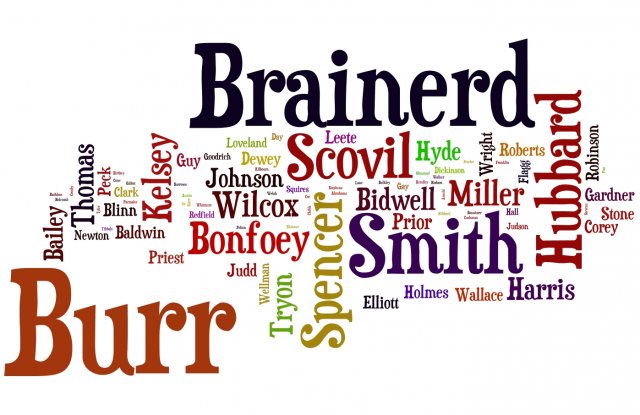I've written about Porter's Uncle Harry here before, but this article from the Cypress Cemetery website just came to my attention, so it seems appropriate to post it for family members this Veterans Day.
One veteran in particular was noted enough so as to be commemorated with a park and a National Honor Roll Memorial Tree, the large oak located in the northern part of the Annex. His name was Harry Gilbert Faulk and of the 28 veterans in Cypress who fought in World War I, he was the only Saybrook resident actually killed in action - in France on July 25, 1918 at 20 years of age. Company C of the 101st Machine Gun Battalion, to which Harry was attached, was heavily shelled while sleeping on the edge of some woods north of Chateau Thierry on the morning of the 25th which resulted in significant casualties. Harry, who was mortally wounded, was one of the casualties.
It's a good article, though it implies that the store was owned by Harry's parents, and Porter's sure it belonged to Harry's brother, Fred. It was always referred to as "Uncle Fred's store." Any family members remember differently?
Harry was the youngest of six children of Frederick Olaf and Hilma Justina Faulk, who were both born in Sweden. The Faulks were well known in Old Saybrook and on Saybrook Point in part because they owned a small store at the corner of Bridge Street and College Street that also included a post office (photo at left). The location is now occupied by one of the condominium buildings of the Saybrook Point Hotel complex. One can imagine that young Harry spent a lot of time at the family store.
Happy Veterans Day to all, and thanks to all who who serve today or have served in the past.
Thanks to my NEHGS newsletter, I can point to where my own observations are confirmed (and explained) in print. The Summer 2014 edition of the Old Sturbridge Village Visitor reports on some historical myths, one of which is that everyone died young in the olden days. I get so frustrated when people attempt to explain something in the past by invoking, "because they only lived to be 40 years old." Many of my ancestors lived into their 70's, 80's, and even 90's. Here's the explanation:
While average life expectancy was shorter in 19th-century New England than it is today, many people then lived into old age, and some even lived beyond 100 years. The Bible says that expected lifespan 3,000 years ago was "70 years; 80 for those who are strong" (Psalm 90:10). But before the mid-20th century, people died regularly in all stages of life, not just in old age. Life expectancy at birth in early 19th-century New England was only in the mid-40s.
But as the old saying goes, "there are three kinds of lies: lies, damned lies, and statistics." Statistics in the 19th century were skewed by high childhood mortality rates—especially in urban areas—largely due to infectious diseases such as pertussis, measles, scarlet fever, and diphtheria. (Thanks to vaccination, these diseases are rare today.) By the time a person reached age 30 his life expectancy jumped to 67 and the average 50-year-old could expect to live until age 73.
Note that this still puts many of my ancestors above average, but that's no surprise. :)
Except for the obvious connection between his middle name and his maternal grandfather, Daniel Porter Stücklin was not named for anyone in particular. But out of a surfeit of genealogical curiosity, I looked up Daniel Porter (with Porter as a surname, not a middle name) in my genealogical database.
It turns out I have five Daniel Porters recorded, though none born later than 1750. Of these, two are direct ancestors.
Dr. Daniel Porter, who came to Connecticut before 1644 and was one of the founders of Farmington. He is Daniel Porter Stücklin's 10th great-grandfather on my side.
Daniel Porter, born January 1726, the son of John Porter and Esther Deane, and the great-great grandson of immigrant ancestors John Porter and Anna White. He also lived in Connecticut, and is Daniel Porter Stücklin's 6th great-grandfather on Porter's side.
As a homemaker, I don't find Mondays to be the horror that many people do. But at the moment I'm feeling a little more sympathy with that point of view.
I will soon find myself in the Phildadelphia area with a day to spare. A Monday, to be precise. "Ah ha!" I thought. "A perfect day for some genealogy research." It's not all that infrequently that I find myself somewhere interesting, genealogically speaking, but my time is almost always taken up by Higher Priorities, i.e. family. But I will be briefly at loose ends this time, and was looking forward to a lovely day spent with books, papers, and my computer.
Lancaster, Pennsylvania, holds some important clues for one of my genealogical brick walls. My first stop I intended to be at the Lancaster County Historical Society's library. It looks promising, but it is
Closed on Mondays.
Okay, on to Plan B. The Lancaster Mennonite Historical Society also has some of the books I'm interested in. But alas, it is also
Closed on Mondays.
Well, how about a Plan C? Harrisburg is the home of the Pennsylvania State Library, which holds potential material for both my eastern and my western Pennsylvania family, and it's not all that far from Philadelphia. But, you guessed it: it is
Closed on Mondays.
Garfield would approve.
Ancestry.com is opening all its U.S. census records (1790-1940) for free from now through September 3. The census is one of my favorite sources of genealogical information, and a lot of fun to check out. Enjoy!
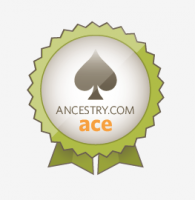 As noted in a previous post, I've been having a blast with the just-released 1940 census. I did not use Ancestry.com's census site as much as I had hoped, as the locations they chose to upload first were not the ones I was, at the time, looking for. (Their census maps were invaluable, however.) Initially I had to depend on the National Archives' site, which was more than a little frustrating, as they had seriously underestimated how high demand would be, and the system crashed early in the day. By the next day it was up, but slow. Still, I didn't mind too much clicking "next page" and then doing something else for a while. What was most exasperating was the inability to choose to go to a specific page number without going through the agonizing "next, next, next" process.
As noted in a previous post, I've been having a blast with the just-released 1940 census. I did not use Ancestry.com's census site as much as I had hoped, as the locations they chose to upload first were not the ones I was, at the time, looking for. (Their census maps were invaluable, however.) Initially I had to depend on the National Archives' site, which was more than a little frustrating, as they had seriously underestimated how high demand would be, and the system crashed early in the day. By the next day it was up, but slow. Still, I didn't mind too much clicking "next page" and then doing something else for a while. What was most exasperating was the inability to choose to go to a specific page number without going through the agonizing "next, next, next" process.
I found Steve Morse's site more useful than the NARA's site itself, even though he links to the NARA images. Don't ask me how he did it, but I got a much faster (though still slow) response time for the NARA images through his site than directly from theirs.
Easiest of all to investigate were my Florida relatives, as Florida was one of the first states uploade by FamilySearch. They, at least, know the value of the ability to "go to page 5"! Their save image function worked better than the NARA's did in the early days, also.
The great news is that Ancestry.com says it will have every image online by no later than 2 p.m. tomorrow (Friday). Remember, the 1940 census is free on Ancestry for all of 2012, and much more of Ancestry's impressive content is free until April 10. FamilySearch is always free.
Ancestry's YouTube channel has a number of videos that might be helpful for someone who wants to dive into this.
As for me, I plan to investigate the Ancestry site once the database is complete, but basically I'll have to wait until the images have been indexed to do much more. I found all eight of our grandparents and their families, plus a few others who were nearby, because I already knew where they were living in 1940. For those whose location I'm trying to discover, it makes no sense to spend hours and hours pouring over census images when merely waiting will make the job so much easier. I'll admit it's fun, though!
I'm as concerned about privacy as the next person (and a lot more than many), but sometimes I think our government goes too far, such as when it waits till 72 years post facto to release federal census data. But tomorrow, at last, is the day I've been waiting for since I began genealogy work ten years ago: the release of the 1940 census.
When that happens, Ancestry.com and other organizations will go into high gear to get the images available, online, and indexed. Ancestry is a subscription service, but is making the 1940 census available for free during 2012. Until the searchable index is available, it will be necessary to go through the more laborious process of manually searching the records by Enumeration District. I plan to do that for a few of my relatives and other research interests, because I can't wait, but will put off the majority of my 1940 research until the index is available. Patience will be rewarded with a large time savings. :)
Below are some helpful 1940 sites.
Ancestry's 1940 page (or click on the Ancestry Ace image in the side panel to the right)
Tools to help find an Enumeration District
Ancestry.com's Enumeration Distrcit maps
UPDATE: I'm also putting the National Archives 1940census.archives.gov link here, because they have all the images available, and Ancestry.com is still in the (slow) process of uploading them. I'm not sure how much good this will do, however. While I can get to the NARA site, I still haven't gotten my first image to appear. As NARA said on their Facebook page,
After waiting for 10 years for the release of the 1940 census, we know that you are frustrated with the difficulties we're experiencing on our 1940census.archives.gov site. We completely share these frustrations! Since 9 a.m. EDT (when the site went live), we've had about 22.5 million hits to the site, which works out to about 1.9 million users. Although we developed detailed plans and our testing indicated that NARA and Inflection would be able to handle the expected load,the number of visitors was huge. Thank you for your patience despite these frustrations. We're working to resolve the problem and we'll keep you updated on the situation.
And here's the FamilySearch 1940 Census link; they are also uploading the images and have a different set available so far from Ancestry's.
What was Hallowe’en like when you were a little girl, Grandma? 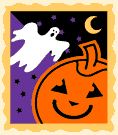
No one has as yet asked me that question, but if things run true to form for most Americans, someone will, someday, after I am past being able to respond. So I will answer it now.
My Hallowe’en formative years were in the 1950s and early 60s, in a small village in upstate New York. Contrary to what we’d like to believe, it was not an idyllic and crime-free time. One of my first (and worst) Hallowe’en memories was of the teenaged thugs who thundered onto our porch, grabbed our carefully-carved jack-o-lanterns, and smashed them to bits. I lived a sheltered life: this was my first view of senseless, wanton destruction; my first encounter with people who get pleasure from breaking the hearts of little children. Our tiny village did not escape teen gangs and vandalism, which seemed to be more widespread, if much less dangerous, in those days. At least they attacked property, not people.
That was the only scary thing about our Hallowe’ens.
The most important difference between Hallowe’en then and now is that the occasion was first, last, and always for children. A few adults dressed in costume for the neighborhood parade and party, but the purpose of the event was to entertain the children. The only excuse for anyone over 12 going out trick-or-treating was to escort the younger ones—every once in a while a compassionate homeowner would give us a piece of candy, too. Now, when high schoolers come to my door, I give them candy if they’ve made any attempt at a costume, but I pity them, that at their age they are begging door-to-door for candy instead of helping younger children to have a good time.
On the other hand, teenaged trick-or-treaters is a clear improvement over teenaged vandals.
The Hallowe’en season began several weeks in advance of October 31. No, not because Hallowe’en stores began popping up all over town, and shelves everywhere sprouted candy in yellow and orange. Because of the costumes. Store-bought costumes were largely unavailable, and anyway, who would have wanted one? Hallowe’en was an occasion for great creativity. Merely deciding what to be could take a month. (Decisiveness, I’ll admit, was never my strong suit). Those who come to our door today are mostly beings—a cat, a princess, a Star Wars character—but we favored things: one might be a rocket ship, a pencil, or the whole Mad Hatter’s Tea Party (no relation to the present-day Tea Party, as mad—in either sense—as they may be). The challenge was to create a costume from whatever we could scrounge around the house without actually having to spend money. No problem—we had not yet forgotten what any five-year-old knows: the cardboard box is the most universally useful of all materials. (More)
Permalink | Read 3311 times | Comments (12)
Category Genealogy: [first] [previous] [next] [newest] Children & Family Issues: [first] [previous] [next] [newest] Random Musings: [first] [previous] [next] [newest] Everyday Life: [first] [previous] [next] [newest]
Providence, Rhode Island.
My college roommate was from Providence. I drank an Awful Awful at the Newport Creamery on one visit, and worked for a day in a Brown University chemistry lab on another. I have pleasant memories of visits with her family, and of driving there from Boston, years later, when my brother's job took him to Providence one day and we met at an Indian restaurant for dinner. I've passed through T. F. Green airport countless times.
My allegiance to that New England city was cemented by the discovery that the founder of Providence, Roger Williams, is my tenth great-grandfather. He's Porter's ninth great-grandfather as well. So you might say Providence is in the family.
Thus I was thrilled to learn that the town charter of Providence, brought from England by Roger Williams himself in 1648, has been found, after some 140 years of "missing and presumed dead" status.
It was discovered by Paul R. Campbell, the city archivist, who "spends his days burrowing in the very attic of City Hall amid peeling paint, stacks of ponderous tomes and dusty boxes shielding secrets of the past, from the humdrum to the historic."
As he tells it, one recent Friday afternoon, a group came seeking certain records. As Campbell poked around material stored on a level above his office, he came across an open box. Inside sat a pocket folder from the 1960s, containing miscellaneous records of the now-defunct Providence Board of Aldermen.
But in the box there also reposed “a very old document, on vellum [animal skin],” he said. “I recognized right away the writing style of the 17th century — I did some research some years ago on 17th-century writing. It began to look like something more important than a deed. It was governmental in nature.”The signature of “John Warner, Clerk of the Assembly,” caught his eye. It dawned on him that here might be something momentous.
“I figured this was the John Warner, one of the early arrivals. The document, in a nutshell, is from when Williams came back from England in 1643 after he had obtained a charter from the king for the Colony of Rhode Island. He needed to get a charter for the Town of Providence, so he went to the Colonial Legislature of 1647-48, and asked for a town charter. This document is the town charter issued in March 1648. This is the Town of Providence creation document.”
What's in your attic?
It's not the New York Times, or even the Hartfort Courant, but I'll thank the East Haddam-Haddam Patch for their article on the quilt show, and their mention of Phoebe's Quilt. (H/T PJS) As is true with most newspaper articles I've known the truth about, this one manages to tell gist of the story accurately while erring in the details.
One of the most interesting ... had to be Prudence Sloane’s quilt.
“I inherited a trunk from my mother, this was in the bottom of it,” Sloane said. The quilt contained the names of family ancestors stitched into it.
It turned out the quilt belonged to Phoebe (Burr) Scovil, Sloane’s first cousin four times removed. It was most likely a wedding present from friends and family around 1849. Sewn into each square section of the quilt was a different person’s name.
Sloane’s sister-in-law, Linda Wightman, who was very interested in the family’s genealogy, did research on all the names of the people on the quilt. Wightman even went to Boston to investigate the names in a genealogy library.
Wightman made a booklet and gave it to Sloane as a Christmas present with information on Phoebe and how each person sewn into the quilt was related to her.
The quilt actually belonged to Phoebe L. (Scovil) Bonfoey, who is, indeed, Prudence's first cousin four times removed (and my fourth cousin four times removed, for that matter). Phoebe (Burr) Scovil was her mother. The creation of the quilt was most likely around 1849, the year one of the signers died and one, who signed with her married name, got married. Phoebe herself married Horace A. Bonfoey in 1852.
To say that I "even went to Boston to investigate the names in a genealogy library" sounds rather pathetic unless you realize that I, unlike the quilt, don't live in Connecticut. In any case it's not something to be impressed about; whenever I make the (all too rare) visit to Boston, New York, Hartford, or other research hot spot, it's for a lot more than just the quilt. Most of my research for this project was done using the amazing resources available online. That's not to say I couldn't have walked to Boston in the time it took me to gather the information—not true, but at times it felt like it.
And, hey—they spelled my name right! I'm sure I have Prudence to thank for that.
I created a Wordle picture of all the surnames I have associated with the people who made Phoebe's Quilt: maiden and married names, names of parents, spouses, and spouses' parents. (Click on the image for a larger view.)
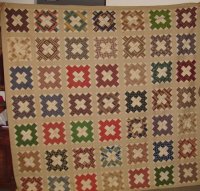 The project that consumed my life since mid-January has now reached—not completion, but a stopping point. Deadlines can be a blessing.
The project that consumed my life since mid-January has now reached—not completion, but a stopping point. Deadlines can be a blessing.
This particular deadline was the Haddam Neck Congregational Church Annual Quilt Show, coming this Saturday, April 9. Phoebe’s Quilt will be exhibited there, meaning the real thing, not my book about the signers of this Friendship Quilt. Fortunately, the quilt owner gave me plenty of notice, because when she asked for a few copies of the book to have at the show, I knew I couldn’t simply print them off.
The first edition of Phoebe’s Quilt had bumped up against its own deadline, which was Christmas 2009. I hadn’t thought much about it since, but the knowledge of what had been left undone would not let me rest until I had completed a revised version for the quilt show.
Amazingly, much of what is in the second edition could not have been done two years ago, even without the Christmas deadline. Many of the new facts became available online only in the last few months; even as I was buttoning up the revision more data was appearing, making a third edition inevitable. (More)
Too many short nights. 'Way too many long days. I'm currently babysitting the printer as it struggles with the second edition of Phoebe's Quilt, which I plan to take to Office Max tomorrow later today to have covered and bound. Then I'll pack it off to my sister-in-law so she'll have a few copies when she shows the real thing at the Haddam Neck Congregational Church's Annual Quilt Show this coming Saturday. Hopefully that will generate interest among local folks who might be able to shed light on Haddam 160 years ago and the families I've come to know through this Friendship Quilt.
The printer is silent. Four copies printed. I won't bore you with why it took so long to get four measly copies done, but it almost makes Office Max's charge of 50 cents per (color) copy look reasonable. Almost. Anyway, they're done. Tomorrow I'll change out the exhausted black ink cartridge and hope the (already replaced once) color lasts through one more printing.
Then bind ... ship ... and I'll be FREE! Um, not exactly. There's still some work to do on the pdf version, and of course more research I want to do—eventually. But I'm looking forward to scaling back, a lot, and tackling all the stuff that's been ignored for the last several weeks, including the very lovely Florida spring days that will soon pass into not-so-lovely summer.
Anyway, that's why you haven't heard much from me lately.
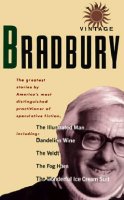 The Vintage Bradbury: Ray Bradbury's Own Selection of His Best Stories, by Ray Bradbury (Vintage, 1990) (original copyright 1965)
The Vintage Bradbury: Ray Bradbury's Own Selection of His Best Stories, by Ray Bradbury (Vintage, 1990) (original copyright 1965)
I picked this book out from my son-in-law's collection because my nephews had recently read Something Wicked This Way Comes for their book club, and I realized I hadn't read any Bradbury in a long time.
Now I'm probably done for another five years or so. Some of the stories were enjoyable, but most I found too weird and depressing for me. Tales of bizarre "healers" whose treatment of choice turns out to be rape, and of children plotting to kill their parents—not to mention babies murdering their mothers!—are not worth spending precious reading time on. I'm very sensitive to the content of what I read and watch—One Flew Over the Cuckoo’s nest troubled me for years—and find it better not to give my mind too many dark ideas upon which to brood.
On the other hand, nobody writes like Ray Bradbury. I wish he had put his imagination and incredible descriptive skills to a more uplifting purpose; he’s a genius, without doubt. His stories are about as close to poetry as prose can get—at least not without falling into the outlandish world of James Joyce.
And family is family. Ray Bradbury is my sixth cousin twice removed. 
Now I'm probably done for another five years or so. Some of the stories were enjoyable, but most I found too weird and depressing for me. Tales of bizarre "healers" whose treatment of choice turns out to be rape, and of children plotting to kill their parents—not to mention babies murdering their mothers!—are not worth spending precious reading time on. I'm very sensitive to the content of what I read, or watch—One Flew Over the Cuckoo’s nest troubled me for years—and find it better not to give my mind too many dark ideas upon which to brood.
On the other hand, nobody writes like Ray Bradbury. I wish he had put his imagination and incredible descriptive skills to a more uplifting purpose; he’s a genius, without doubt. His stories are about as close to poetry as prose can get without falling into the outlandish world of James Joyce.Our census form arrived. In a word: B-O-R-I-N-G.
It's a good thing for future genealogists that we have so many other forms of record-keeping, because they won't get much from the 2010 census. Name, sex, date of birth, race in excruciating detail if you're Hispanic, Asian, or Pacific Islander (Dominican? Hmong? Fijian?), relationship to head-of-household (now inoffensively called "Person 1" — also in excruciating detail, distinguishing, for example, between biological and adopted children, which genealogists will love, if no one else). That's only if you're one of the first six people in the household. For Persons 7 through 12 they don't care about your race or exact relationship. And if you're the 11th child in the family? Apparently you're out of luck, but I suspect that may be covered by the "we may call for additional information" caveat that goes with the questions for Persons 7 - 12, since there's also a place to indicate the total number of people in the household.
I wrote before about the interesting information in previous censuses, but I'll repeat it for this occasion. (More)

